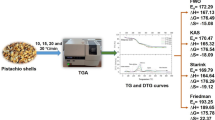Wood vinegar (WV) is the one of the primary liquid products of biomass pyrolysis, and applied as a sustainable chemical in industry and agriculture. The present work focused on the corrosivity of WV obtained from hazelnut shells pyrolysis to provide more sufficient premise reference for better application. It is found that, the optimal temperature for maximum WV yield (31.23 wt.%) was located at 700°C, the higher temperature (>700°C) was not conducive to the generation of WV, the low pH was important quality for WV, the average value of pH was 2.89 in the all selected temperatures, this is mainly attribute to the high content of phenols and acids in WV by gas chromatography-mass spectrometry technology, and phenols were the most important components, and accounted for above 41.17 wt.% in WV. Corrosive experiments showed that WV had the weaker corrosiveness than the typical formic acid, it was supported by the comparative result on the roughness, hardness, and tensile strength of the rubbers soaked in WV and formic acid, and the corrosivity decreased first and then increased with the increase of preparation temperature of WV, the WV prepared at 900 °C had the weakest corrosiveness, it revealed that the corrosivity of WV mainly were affected by the content of acids in WV, and more phenols supported the lower pH and lower corrosivity of WV, phenols were acidity similar to acids, the corrosivity were significantly less than acids.





Similar content being viewed by others
References
A. Grewal, L. Abbey, L.R., Gunupuru, Journal of analytical and applied pyrolysis, 135, 152-159 (2018).
M. Hagner, O.P. Penttinen, K. Tiilikkala, et al., European journal of soil biology, 58, 1-7 (2013).
J. Chen, J.H. Wu, H.P. Si, et al., Journal of Plant Nutrition, 39, 456-462 (2016).
Z. Li, L. Zhang, G. Chen, et al., Process biochemistry, 75, 194-201 (2018).
İ. Koç, E. Öğün, A. Namlı, et al., Fresenius Environmental Bulletin, 28, 2747-2753 (2019).
A.M. Sayed, R.W. Behle, K. Tiilikkala, et al., Pesticidi i fitomedicina, 33, 39-52 (2018).
R. Xue, E.L. Cui, G.Q. Hu, et al., Industrial Crops & Products, 178, 114586 (2022).
H. Desvita, and M. Faisal, Materials Today: Proceedings, 63, S210-S213 (2022).
S.S. Lee, B.J. Ahn, S.T. Cho, Journal of the Korean Wood Science and Technology, 38, 341-348 (2010).
İ. Koc, E. Ögun, A. Namli, et al., Applied Ecology and Environmental Research, 17, 2437-2447 (2019).
C.Y. Ju and G.S. Wan, Journal of Life Science, 17, 105-109 (2007).
H.X. Wang, A. Gross, J. Liu, Chemical Engineering Journal, 433, 133692 (2022).
M. Bertero, H.A. Gorostegui, C.J. Orrabalis, et aL., Fuel, 116, 409-414 (2014).
H.P. Yang, R. Coolman, P. Karanjkar, et al., Green Chemistry, 19, 286-297 (2017).
S. Xia, K. Li, H. Xiao, et al., Bioresource technology, 287, 121444 (2019).
S. Stegen and P. Kaparaju, Fuel, 276, 118112 (2020).
L. Qin, Y. Shao, Z. Hou, et al., Energy Sources, Part A: Recovery, Utilization, and Environmental Effects, 42, 2831-2843 (2020).
A.E.M. Fodah, M.K. Ghosal, D. Behera, International Journal of Energy Research, 45, 5679-5694 (2021).
S.J. Kim, S.H. Jung, J.S. Kim, Bioresource technology, 101, 9294-9300 (2010).
A. Demirbas, Journal of analytical and applied pyrolysis, 76, 285–289 (2006).
R. Kadir, M. Sarif Mohd Ali, S.N. Kartal, European Journal of Wood and Wood Products, 80, 45-56 (2022).
S.C. Hu, J. Cheng, W.P. Wang, Energy, 239, 121918 (2022).
Q. Wei, X. Ma, J. Dong, Journal of analytical and applied pyrolysis, 87, 24-28 (2010).
J. L. Aguirre, J. Baena, M.T. Martín, et al., Energies, 13, 2418 (2020).
Q. Zhang, J. Chang, T. Wang, et al., Energy conversion and management, 48, 87-92 (2007).
V. Chiodo, G. Zafarana, S. Maisano, et al., Fuel, 164, 220-227 (2016).
C.X. Zhao, E.C. Jiang, A.H. Chen, Journal of the Energy Institute, 90, 902–913 (2017).
S. Mathew, Z.A. Zakaria, N.F. Musa, Process Biochemistry, 50, 1985–1992 (2015).
J.E. Omoriyekomwan, A. Tahmasebi, J. Yu, Bioresource technology, 207, 188-196 (2016).
Q. Lu, W.Z. Li, X.F. Zhu, Energy conversion and management, 50, 1376-1383 (2009).
Acknowledgements
This research was funded by the Natural Science Foundation of Heilongjiang Province of China (grant number: LH2020F010), and Harbin Science and Technology Plan Project (grant number: ZC2022ZJ006006).
Author information
Authors and Affiliations
Corresponding author
Additional information
Translated from Khimiya i Tekhnologiya Topliv i Masel, No. 3, pp. 102–107 May – June, 2023.
Rights and permissions
Springer Nature or its licensor (e.g. a society or other partner) holds exclusive rights to this article under a publishing agreement with the author(s) or other rightsholder(s); author self-archiving of the accepted manuscript version of this article is solely governed by the terms of such publishing agreement and applicable law.
About this article
Cite this article
Dai, B., Ding, Z. Corrosivity of Wood Vinegar in Bio-Oil from Hazelnut Shells. Chem Technol Fuels Oils 59, 551–560 (2023). https://doi.org/10.1007/s10553-023-01555-z
Published:
Issue Date:
DOI: https://doi.org/10.1007/s10553-023-01555-z




